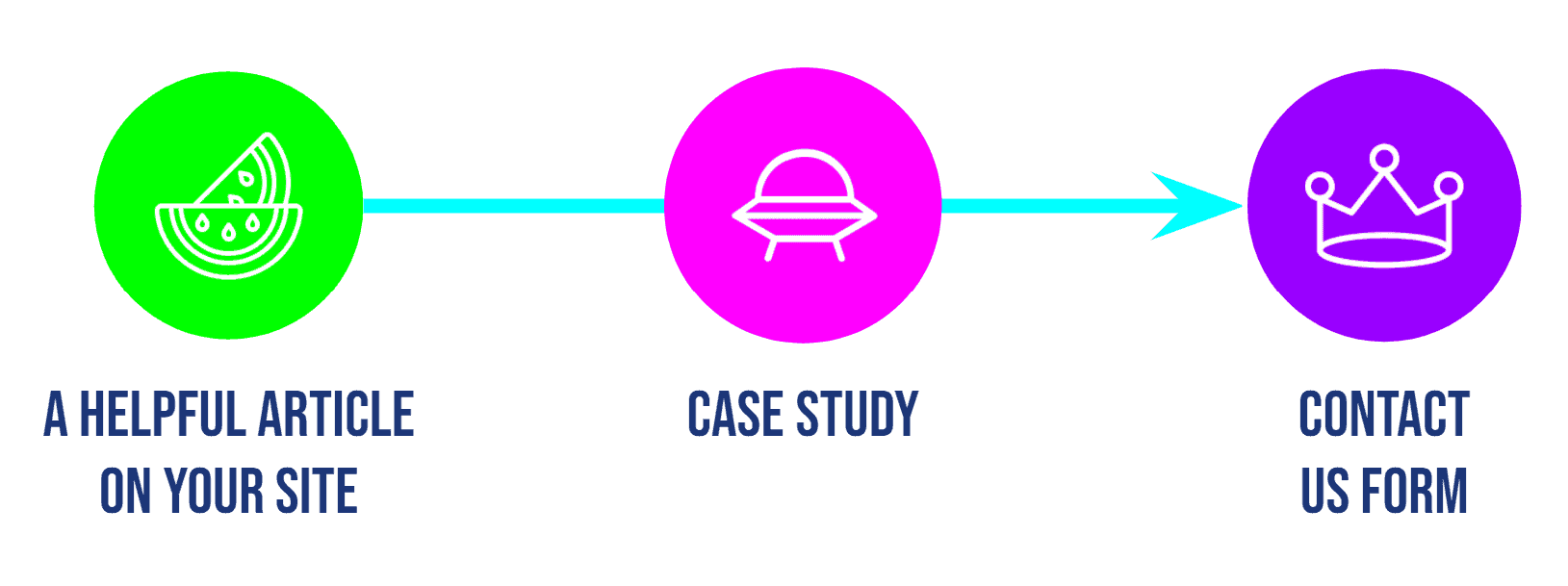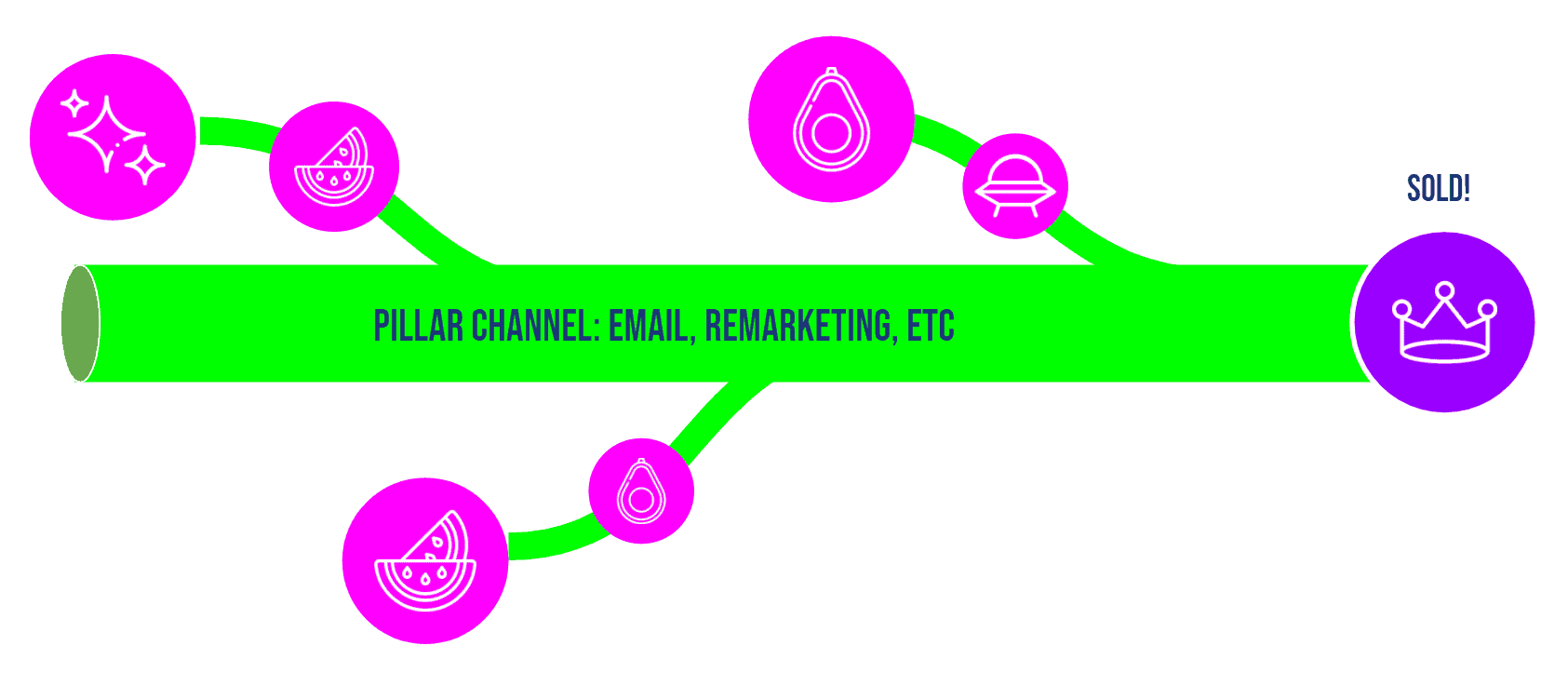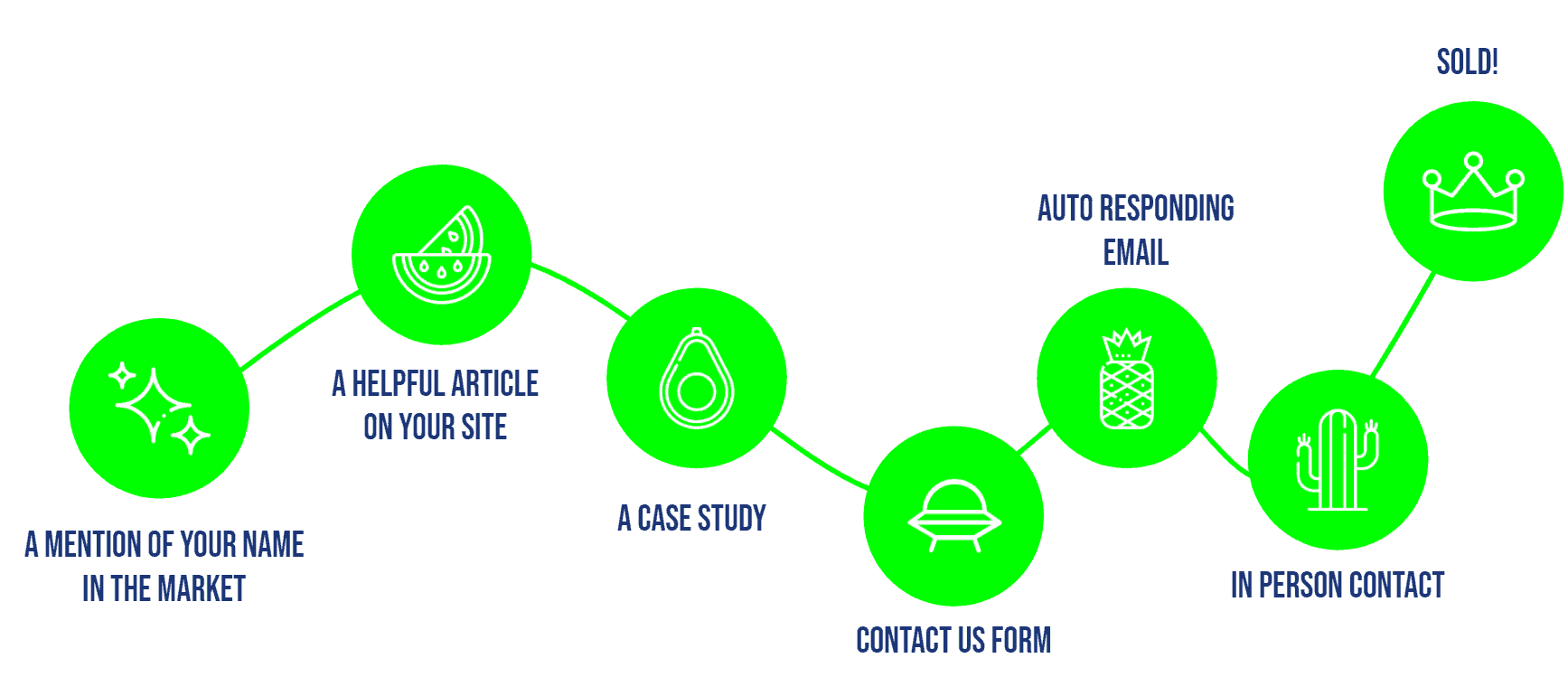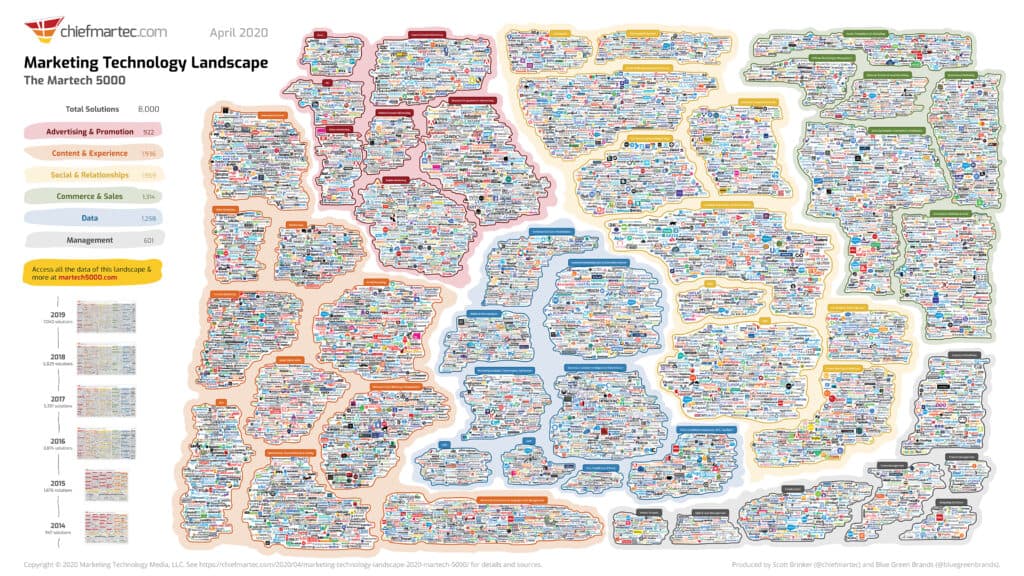Three Ways to Incorporate Click Paths
...in Your Marketing Strategy
THIS ARTICLE MAY CONTAIN AFFILIATE LINKS THAT PAY US A SMALL COMMISSION AT NO EXTRA COST TO YOU. READ OUR AFFILIATE DISCLAIMER.
Ok, so you’re busy. Between managing the team and keeping the programs running smoothly, it can be easy to forget that leads are actually people. They have intentions (you know this), desires (duh), and the need to get their needs met (don’t we all?). But when the business of running a department gets the better of us, we often forget to plan the small, but mighty journeys our leads should follow to a) get their questions answered and b) end up closer and closer to conversion.
Planning ahead can feel like an impossible task if you’re already overwhelmed. But an unmapped customer journey is akin to balls falling down a plinko board. The prospect bounces around from peg to peg guiding themselves through the journey at their whim. They could end up in the wrong slot at the bottom, or worse, fall off of the peg board entirely.
What the customer journey really needs to be is a carefully crafted stairway that lowers them to the depths of your brand’s awesomeness. Think of your lead as a slinky. Your executed strategy creates the momentum that guides them toward a decision to hire you to solve their juiciest problems.
So this blog will walk you through sustainable, easily implemented click path approaches that will help carefully curate your customer journey, one click at a time.
Assumptions
Of course, there are a few things I assume you have to get started:
- Products and/or Services – you know what you provide to customers and you do it well
- Personas – you know who your best customers are and the challenges that drive them to your product or service
- Channels – you already have a few established channels you can use to drive content like social media platforms and email lists
But First We Dance
But first, let’s just celebrate that you got leads in your funnel! THAT IS AWESOME!
Now we really need to start by asking ourselves some hard questions about the path in which your prospects have come to you. By better understanding that, we can understand the context of how to give them the best experience on our properties.
Here are the questions I recommend starting with:
- How did they find you?
- What is this potential customer searching for?
- What do they need to make a decision?
- How do they best consume information?
- How can you make it easy for them to commit?
These questions will help you decide on the type and topics of content that you’ll need serve next.
Here is an example. You’re the proprietor of an ice cream shop. It’s a pandemic and you’re trying to keep your business open and keep the fun that comes with an ice cream parlor. You put an ad out on Facebook. Here’s what we know:
- Customer clicked: Advertisement for a list of top 10 ice cream flavors of all time
- Customer ends up on a blog that lists the top 10 ice cream flavors of all time
- Customer reads article, and gets to the bottom.
What CTA makes sense here? Here are a couple of options:
- Take our favorite ice cream survey and enter to win a prize. This will require them to put in an email address, that you will use to keep in touch with them.
- Create an article that explains how we make our ice cream taste the best.
- Learn about Ice Cream Delivery.
- Create an article that shares the weirdest ice cream flavors.
Which one will help you drive the customer to the next stage of the buying cycle most effectively? Think it through.
This type of planning ahead will help you build a relationship with your prospect over time and ultimately help them turn from a visitor into a customer. But you need to be intentional about it. It can be hard to find the time, so we recommend building it into your content planning process. When you write a pillar piece, what do you want them to do next? The good news is that it doesn’t have to be an overwhelming process. You can get started one bite at a time.
Good: Three Steps Ahead Method
Not sure where to start with click paths? No problem! Just think three steps ahead.

This is the path for someone who needs to start somewhere. In fact, I once went to a session at Content Marketing World where a lady from a major company (I think it was Oracle? I can’t remember, the pandemic has wiped out my long term memory) shared their nurture program. The diagram was crazy. It looked like a ball of yarn. Someone in the audience asked “how did you map these all out? It looks so complex!” She said, “we started simple and layered in complexity over time.” That response really stuck with me. It illustrated how, like with everything in life, you need to take one step at a time to get where you want to go. And that’s what you can do here. Start simply. So, in three steps ahead, you focus on just the three next steps after you create every piece of content.
What you need to consider when planning click paths
Here are the things you need to consider when planning out this three-step click plan:
- What topic brought them to your site?
- What’s another way that you can help them resolve the challenge they came to you for or another piece of related information that will be useful to them?
What tech?
The technology for executing your click path strategy is pretty low profile. You’ll need a platform to help you track the execution of these paths. You can use something all-inclusive like Mailchimp. They provide you the ability to create landing pages, store files, and fill out forms. Or you can stitch together your website and an analytics platform like Google Analytics and use UTM codes to help you track the success of your campaigns. Regardless, it’s a pretty inexpensive way to launch your first click paths.
After you’ve mastered the three steps ahead path, you’ll want to graduate into a longer and more complex approach to help prospects through the whole journey.
Better: Pillar Path
Too busy to create full click paths for every piece of information you publish? Yup, I get that. In this model, we’re focused on creating onramps to an evergreen campaign.

This is great for an organization that is looking to layer in more targeted campaigns but doesn’t want to create a custom click path for every single piece of content they are releasing. This approach relies on a deep understanding of the universal elements that bind your various personas together. For instance, if you have an online service that helps bakeries, retail shops, and independent restaurants manage their human resources, in order to make this strategy sing you will need to understand their common challenge: making sure that employees can access everything they need in one place and make sure that the companies using your product are in compliance with their state’s employment rules.
In this example, let’s say that the pillar channel (the big green pipeline in the middle) is an email nurture program that highlights the benefits, case studies, and newly released features of the human resource service. These messages are universal to bakeries, retail shops, and independent restaurants.
The onramps (little green arms going into the pillar channel) are the short, highly targeted campaigns that drive prospects into the pillar channel. For instance, an onramp might be highly tailored to bakeries and be served via social media ads during a time when people who own bakeries are doing their administrative work. The call-to-action on that ad might be to read a blog that solves a critical problem that bakeries specifically face. And the call-to-action on the blog would drive them back to the nurture email series that acts as the pillar channel.
You might notice that this is just an extended version of the first tactic we mentioned above. Thinking three steps ahead is always a great place to start and then layering in strategic complexity means you can hold your prospect’s hand all the way through the purchase process over a longer period of time without going crazy trying to track a million customer journeys.
What you need to consider when planning click paths
Here are the things you need to consider when planning out the pillar paths:
- What topics and features are universally applicable to each of your audiences?
- What challenges are unique to your priority personas?
- How and where do those personas consume information?
- What’s your budget? Can you add some paid advertising to the mix?
What tech?
In this scenario, you’ll want to start by figuring out what your pillar channel is. Where are you communicating the universal messages that your mini-campaigns will push prospects to? Your budget will dictate a lot of how you approach this.
- If you’re looking at a smaller budget, you can go with an email platform (Mailchimp, Constant Contact, ConvertKit). Then you can use a combination of ad platforms, social media platforms, website platforms, and search engines to drive traffic to your onramps.
- If you’ve got a bigger budget, you likely have a marketing automation platform that acts as both your emailing service, tracking platform, and you can even use it to help execute the customer journey
But, let’s say that you get this down pat. Good news! You can control the experience even more with highly personalized and even more dynamic paths based on your persona.
Best: Customized/Personalized Paths
This is how the fanciest of marketing departments help drive their prospects through the buyer’s journey and straight into the goalie’s net.

Personalized customer journeys or click paths can take two roads: customized or personalized.
Customized Click Paths
Customized means that the marketing organization maps out the steps for a campaign according to the particular campaign manually. For instance, if they find you via someone searching for an answer to a question via a search engine, and they land on a blog, and that blog leads you through a tailored customer journey based on the intent of the original request and cross-referenced with the organization’s persona. It can be as long or as short as needed based on the number of touches it takes to get a customer to conversion.
Because this is done manually, when changes need to be made to reflect shifts in the persona, they need to be done by the marketing team. If mismanaged, this can be a nightmare. Keeping detailed and updated maps is going to be the key to success here because without it, if you end up with a bad link or a defunct bit of information, finding it can be the equivalent of an Easter egg hunt gone wrong. You don’t want to end up leaving a stinky hard-boiled egg somewhere in the yard.
What Tech?
The technology for this one is very similar to our pillar channel approach. Smaller budgets need to focus on a cobblestone approach. Connecting mailing platforms together to create cohesive paths, and a platform that can track the success agnostic of those platforms can help keep things organized. Larger budgets can use tools that are built into marketing automation systems to help them keep everything straight and spot weak spots in their customer experiences.
Personalized Click Paths
Personalization, on the other hand, is the idea that each point in the customer journey serves information and experiences based on what you or some sort of second or third party organization knows about your prospect.
The idea of “personalization” was the darling for a few years as the rise of artificial intelligence and machine learning took over…well, everything. But if you didn’t get on that bandwagon, don’t fret. You might even be better off. People were haphazardly slinging those phrases around without fully incorporating or sometimes even understanding what they might imply to someone using their tool. After a few years of consolidation, the tools that have survived are more useful and more likely to use the type of technology that can serve a marketer efficiently.
What Tech?
With the phrase “digital transformation” on the doorstep of every industry, there are tons and tons of tools out that claim to revolutionize/transform/personalize your customer journey. As you choose from this crazy number of offerings, start with your “must-have” list (and make sure to include integration) as part of your evaluation process. If you focus on tools that give you access or have partners that can augment what information you can use to personalize the experience outside of just what you’ve collected, you’ll be able to fine-tune what they consume more effectively. Of course, you’re always balancing the “creepy marketer” factor. So choose what information you use to interact with them wisely and ethically.
Marketing automation platforms (even more basic ones like the ever-changing/ever-improving Mailchimp) can help create a more personalized experience when you set up a series of triggers that are highly relevant and customized to the intent of the content they’ve consumed. Of course, most major marketing automation tools don’t actually leverage AI (still), there are plenty of tools to append to your tech stack (see previous paragraph). But integration is key to managing the many, many tech products we marketers have to interact with each day.
Context Rules
Remember that effective click paths are 25% technology, 25% planning, and 50% context. How your prospect comes into your funnel dictates where they are in their buying cycle, the nuance of their challenge (depending on how specific the entry point is), and what they do next. You have a juicy opportunity to make that whole path meaningful and carefully crafted to drive them from being a visitor to being a clear customer. Don’t miss the boat.
What’s Next?
If you’re excited about making nuanced and specific content but want to make sure it’s SEO friendly, you likely know there are a lot of tools out there that claim to find you the information you need to narrow down the right keyword. We put together a comparison between Ahrefs vs SEMrush vs Moz.
Love Helpful Insights?
Want no-nonsense tips every week? Get our One-Tip Wonders! You won’t have to dig through messy copy to get what you need. It’s one idea, tip, or strategy each week in just a sentence or two. Easy peasy, and useful.
Impressed by our content?
Get in touch with us. We can spruce up your content and strategy too. Sound good?
